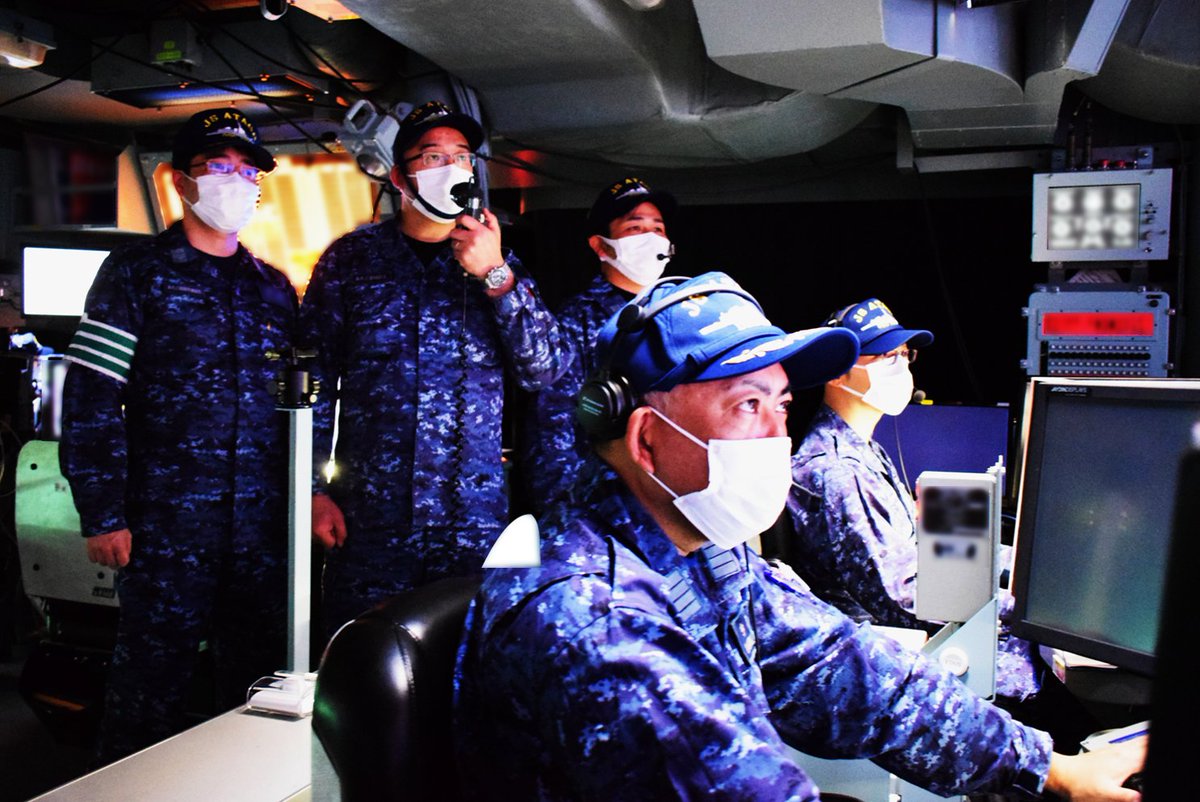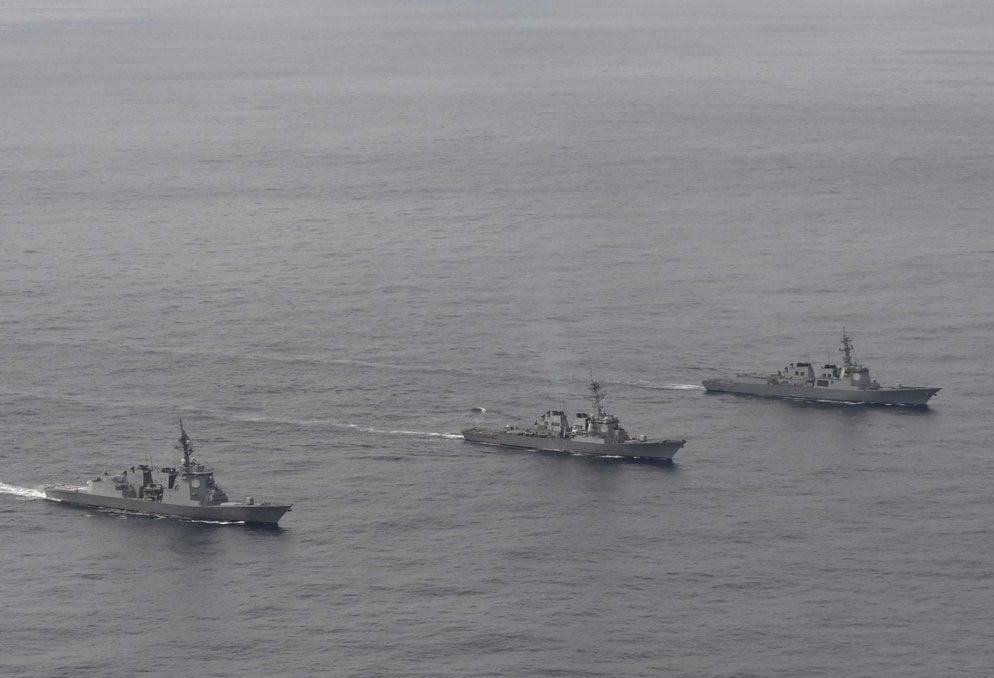
The U.S., Japan and South Korea carried out a trilateral Ballistic Missile Defence (BMD) drill in the Sea of Japan Wednesday in response to North Korean missile launches Saturday and Monday.
U.S. Navy destroyer USS Barry (DDG-52), Japan Maritime Self-Defense Force (JMSDF) destroyer JS Atago (DDG-177), and Republic of Korea Navy (ROKN) destroyer ROKS Sejong the Great (DDG-991) participated in the exercise. Barry departed Commander, Fleet Activities Yokosuka on Feb. 17, as part of a scheduled homeport shift to Everett, Washington, following six years of service forward-deployed to U.S. 7th Fleet.
“This exercise enhances the interoperability of our collective forces and demonstrates the strength of the trilateral relationship with our Japan and Republic of Korea allies. This trilateral cooperation is reflective of our shared values and resolve against those who challenge regional stability. We remain committed to peace and prosperity in the region to uphold a free and open Indo-Pacific,” reads a U.S. Indo Pacific Command release.
Japan and the Republic of Korea also put out their own statements supporting the trilateral exercise.
In its own message, Japan’s Joint Staff Office (JSO) of the Ministry of Defense stated that, “this exercise demonstrates the commitment of Japan, the U.S., and the ROK for further trilateral cooperation to respond to regional security challenges amid an increasingly severe security environment surrounding Japan, including North Korea’s ICBM-class Ballistic Missile launch that landed within Japanese Exclusive Economic Zone in the Sea of Japan, protecting shared security and prosperity, and bolstering the rules-based international order.“
The three countries had carried out a similar BMD drill in response to North Korean missile launches in October last year with five ships involved in the drill.
On Saturday, North Korea launched a single Hwasong-15 ICBM from Pyongyang’s Sunan area after warning on Friday that the U.S. and ROK would face “unprecedentedly persistent and strong counteractions” if the two countries went ahead with planned military exercises. The missile flew for 66 minutes before landing within Japan’s exclusive economic zone in the Sea of Japan, in an area 125 miles west of the island of Oshima Oshima, which lies 30 miles west of the main island of Hokkaido.
On Monday, North Korea followed up by launching two missiles from a 600 mm multiple launch rocket system. Both missiles fell in the Sea of Japan off the east coast of the Korean Peninsula with the first missile traveling for 250 miles while the second traveled for 218 miles, according to Japan’s Ministry of Defense.
Two People’s Liberation Army Navy (PLAN) destroyers were sighted 2 a.m. Saturday, sailing southeast in an area six miles west of Kume island, which is a part of the Okinawa Islands, according to a Monday JSO release.
Images and hull numbers identified the destroyers as CNS Suzhou (132) and CNS Hangzhou (136). Both ships subsequently sailed southeast through the Miyako Strait into the Pacific Ocean, according to the release. Replenishment ship JS Mashu (AOE-425) along with a JMSDF P-3 of Fleet Air Wing 5 based at Naha Air Base, Okinawa, shadowed the PLAN destroyers.
The Miyako Strait between Okinawa and Miyako Island is a regular deployment transit route used by the PLAN when traveling between the East China Sea into the Pacific and returning back into the East China Sea.

U.S. 7th Fleet commander Vice Admiral Karl Thomas, commander in chief of the self defense fleet, Vice Admiral Akira Saito and Commander of the Korean Naval Operations Command Vice Admiral Kim Myung-Soo, participated in Flag Talks among the U.S., Japanese, and Korean fleet commanders aboard the command ship USS Blue Ridge (LCC-19) on Wednesday.
The three commanders condemned North Korea’s unprecedented frequency of ballistic missile launches as a serious threat to regional peace and security, and agreed to further strengthen trilateral response by the U.S., Japanese and ROK naval forces.
“The Self-Defense Fleet maintains readiness, defends Japan in supporting of deterrence and the strong Japan-U.S. Alliance, and contributes to stability in the Indo-Pacific region with allied and like-minded navies,” reads the Japanese release.
Earlier on Sunday, two U.S Air Force (USAF) B-1B Lancer bombers from the 34th Expeditionary Bomb Squadron on the Bomber Task Force deployment at Andersen Air Force Base, Guam, carried out separate deterrence flights with the Republic of Korea Air Force (ROKAF) and the Japan Air Self Defense Force (JASDF) following Saturday’s launch of a single intercontinental ballistic missile by North Korea.
F-35As and F-15Ks fighters of the ROKAF along with USAF F-16s flew with the B-1Bs through the Korea Air Defence Identification Zone (KAIDZ) while the JSO release stated that three F-15s of the JASDF 2nd Air Wing together with four Air Force F-16s conducted tactical exercises with the two B-1Bs over the Sea of Japan.
The exercise was carried out “amid an increasingly severe security environment surrounding Japan” following North Korea’s Intercontinental Ballistic Missile (ICBM) launch that landed within Japan’s EEZ Exclusive Economic Zone (EEZ) in the Sea of Japan, according to the release. “This bilateral exercise reaffirms the strong will between Japan and the United States to respond to any situation, the readiness of JSDF and U.S. Armed Forces, and further strengthens the deterrence and response capabilities of the Japan-U.S. Alliance.”





